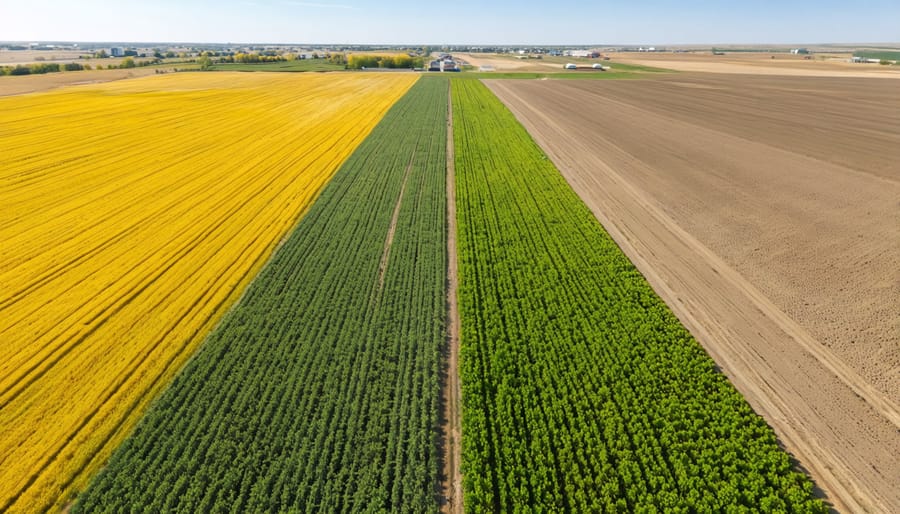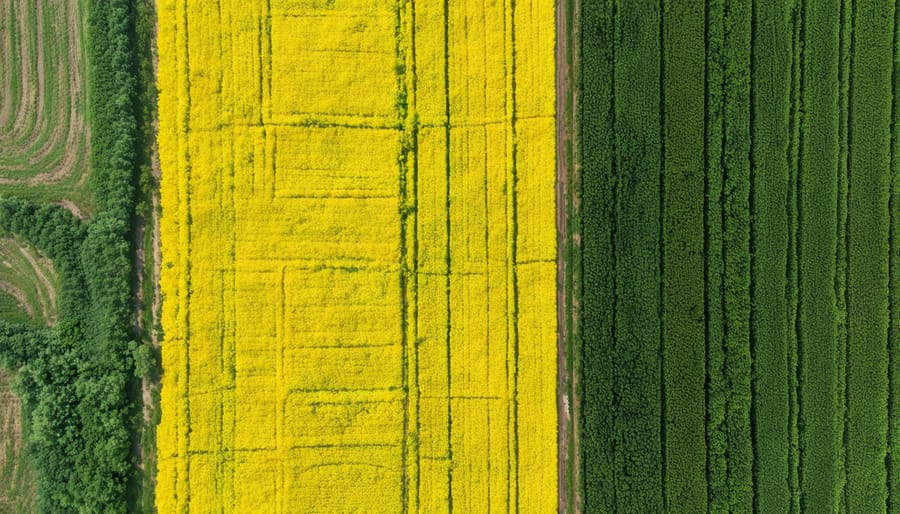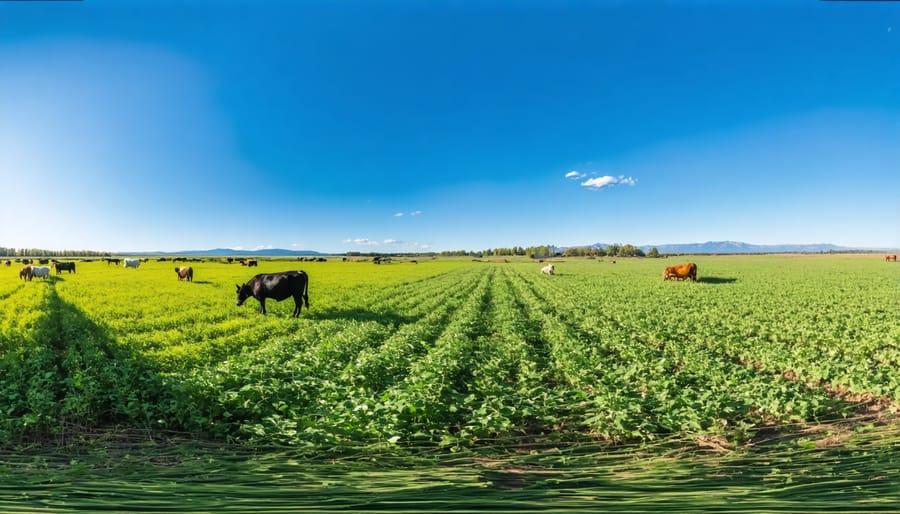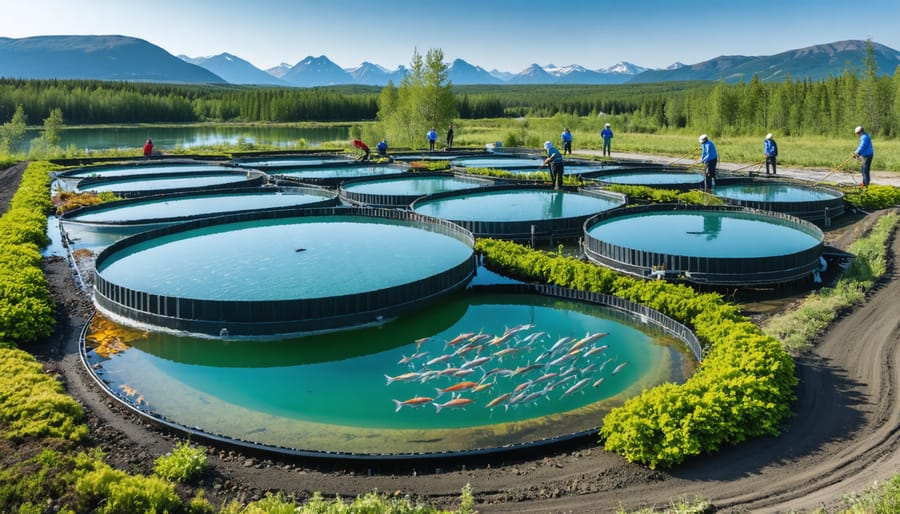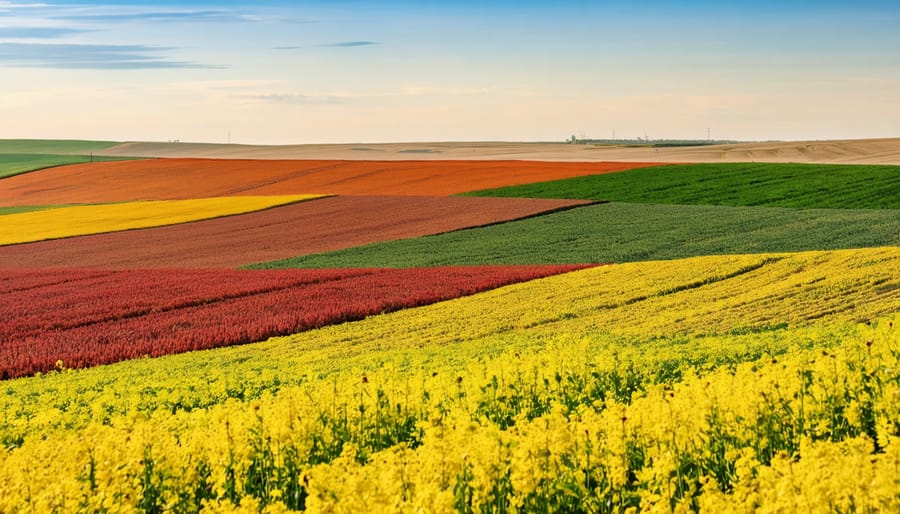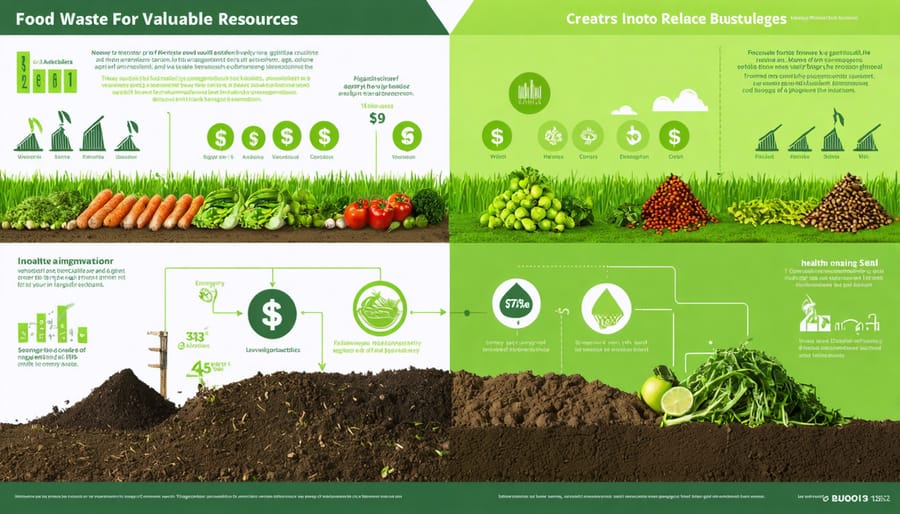Climate adaptation isn’t just about survival – it’s about transforming our agricultural systems to thrive in an unpredictable future. Across Alberta’s farming communities, producers are pioneering innovative solutions that protect both their livelihoods and our food security. From precision irrigation systems that reduce water usage by 40% to drought-resistant crop varieties developed specifically for Prairie conditions, our farmers are leading the way in climate-smart agriculture.
These adaptation strategies have already helped hundreds of local producers maintain profitable operations through extreme weather events. The University of Alberta’s Agricultural Climate Solutions program has documented a 30% increase in farm resilience among operations that implemented comprehensive adaptation plans. By combining traditional knowledge with emerging technologies, Alberta’s agricultural sector is building a model for climate adaptation that works at both individual farm and regional scales.
This practical guide draws from real success stories across the province, featuring proven strategies that can be implemented today. Whether you’re managing a large-scale grain operation or a small mixed farm, you’ll find actionable solutions tailored to our unique growing conditions and backed by local research and expertise.
Smart Crop Selection: Alberta’s Climate-Ready Agriculture
Drought-Resistant Varieties That Work in Alberta
Alberta farmers have made significant strides in adopting climate-resilient crop varieties that thrive in our challenging conditions. AC Strongfield durum wheat has proven exceptionally successful, demonstrating excellent drought tolerance while maintaining high protein content. This variety typically yields 3.5-4.0 tonnes per hectare even during moisture-stressed seasons.
CDC Meadow yellow peas have become increasingly popular, offering both drought resistance and early maturity – crucial attributes for our shorter growing season. These peas consistently perform well with as little as 250mm of seasonal rainfall.
For barley growers, AC Metcalfe has shown remarkable adaptability to dry conditions while meeting malting quality standards. This variety’s deep root system helps access soil moisture at lower depths, making it particularly suitable for southern Alberta’s semi-arid regions.
AAC Crossfield winter wheat deserves special mention for its excellent winter hardiness and drought tolerance. Local trials show it uses 20% less water than conventional varieties while maintaining comparable yields.
These varieties have been extensively tested at Alberta research stations and validated by local producers. Remember that success with drought-resistant crops also depends on proper soil management and timing of planting. Consider your specific soil type and local moisture patterns when selecting varieties for your operation.
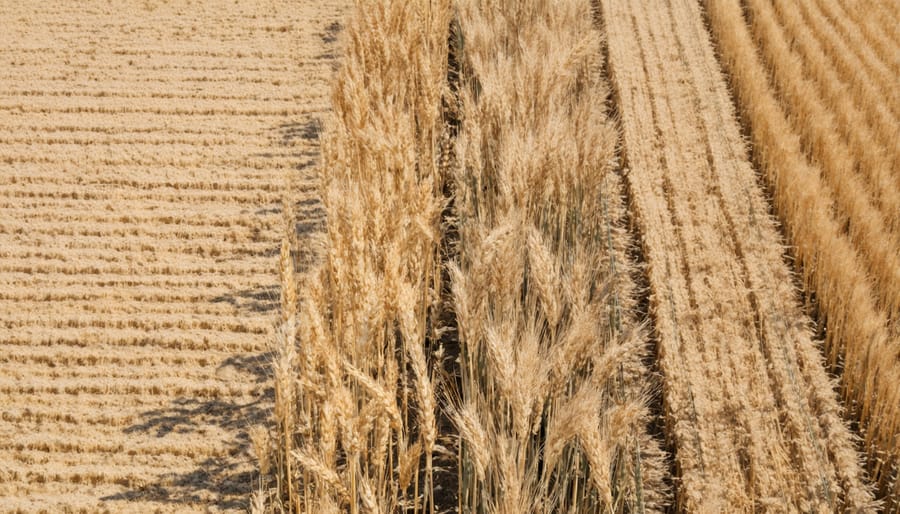
Strategic Rotation Patterns for Changing Weather
Strategic crop rotation has become increasingly vital for Alberta farmers facing unpredictable weather patterns. By implementing thoughtful rotation schedules, you can build soil resilience while protecting your yields against climate variability.
A successful approach we’ve seen across central Alberta involves rotating between deep-rooted crops like alfalfa, which improve soil structure, and shorter-season crops that offer flexibility in planting dates. For example, rotating canola with pulse crops like field peas not only spreads out weather-related risks but also enhances soil nitrogen content naturally.
Local farmer Mike Thompson from Lacombe County shares, “We’ve started incorporating cover crops into our rotation during shoulder seasons. This gives us additional protection against both drought and excessive moisture while improving soil health.” His three-year rotation pattern includes wheat, followed by peas, then canola, with fall rye as a cover crop when conditions permit.
Consider these proven rotation strategies:
– Alternate between early and late-seeding crops to spread out weather risks
– Include drought-resistant crops like wheat or barley in your rotation
– Add nitrogen-fixing legumes to build soil resilience
– Incorporate cover crops during transition periods
Remember to monitor soil moisture levels and adjust your rotation patterns based on seasonal forecasts. Many successful Alberta farmers maintain flexibility in their rotation plans, allowing for last-minute adjustments when weather patterns shift unexpectedly.
Water-Smart Farming Techniques That Save Money
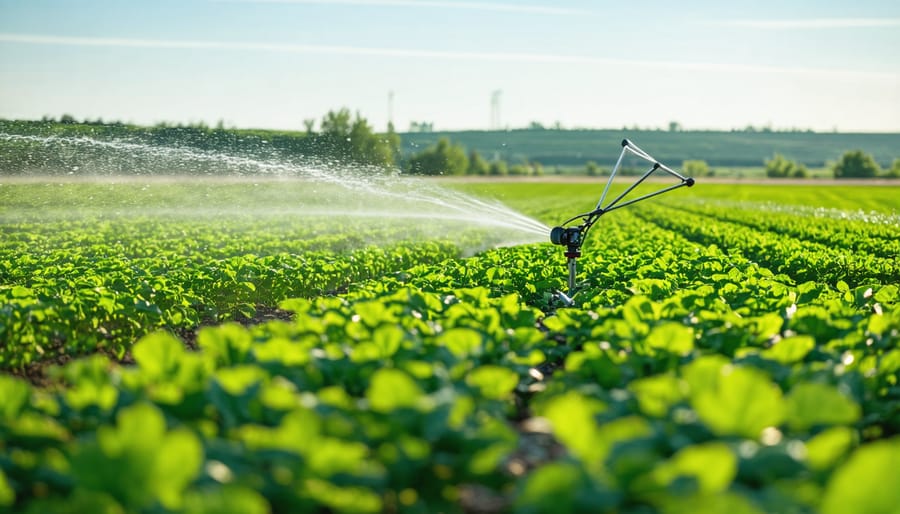
Precision Irrigation Systems
In Alberta’s evolving agricultural landscape, precision irrigation systems have emerged as game-changing water conservation methods that combine technology with traditional farming wisdom. These systems use soil moisture sensors, weather monitoring stations, and GPS-guided equipment to deliver water exactly where and when crops need it.
Local farmer Sarah Thompson from Lethbridge County implemented a variable-rate irrigation system in 2021, reducing her water usage by 30% while maintaining crop yields. “The system pays for itself through water savings and improved crop quality,” she explains. The initial investment, typically ranging from $15,000 to $40,000, can be offset through various provincial rebate programs and increased productivity.
Key components include soil moisture probes that provide real-time data through smartphone apps, allowing farmers to make informed decisions about irrigation timing and quantity. Modern systems can be programmed to automatically adjust water flow based on soil conditions and weather forecasts, reducing labour costs and preventing over-irrigation.
For smaller operations, simpler solutions like drip irrigation systems starting at $5,000 can provide similar benefits. The Southern Alberta Irrigation Projects Association reports that farms using precision irrigation systems typically see a 20-25% reduction in water consumption while maintaining or improving yield quality.
Regular maintenance and proper calibration are essential for optimal performance. Local irrigation workshops and agriculture extension services offer training and support to help farmers maximize their system’s efficiency.
Soil Moisture Conservation
In Alberta’s diverse agricultural landscape, effective soil moisture conservation is becoming increasingly crucial for farm resilience. By implementing strategic moisture management techniques, farmers can maintain optimal soil conditions even during periods of limited rainfall.
Conservation tillage has proven particularly effective in our prairie conditions, with many Alberta farmers reporting up to 25% better moisture retention compared to conventional methods. Using crop residue as a natural mulch helps reduce evaporation while improving soil structure. Local farmer Dave Thompson from Lethbridge County shares, “Since switching to no-till practices five years ago, we’ve seen a marked improvement in soil moisture levels, especially during dry spells.”
Strategic crop rotation and cover cropping play vital roles in moisture conservation. Deep-rooted crops like alfalfa help create channels that improve water infiltration, while winter cover crops protect soil from moisture loss during spring thaws. For optimal results, maintain at least 30% ground cover throughout the year.
Modern soil moisture monitoring tools, such as tension meters and time-domain reflectometry (TDR) sensors, enable precise tracking of moisture levels. These technologies help farmers make informed decisions about irrigation timing and volume, preventing both under and over-watering.
The integration of windbreaks and shelterbelts has shown promising results across the province, reducing wind speeds by up to 50% and decreasing moisture loss through evaporation. Consider planting native species like caragana or green ash, which are well-adapted to our climate and provide excellent wind protection while supporting local biodiversity.
Soil Health: Your Shield Against Climate Extremes
Building Carbon-Rich Soils
Building carbon-rich soils is a cornerstone of effective soil health management and plays a crucial role in climate adaptation. Here in Alberta, farmers are discovering that increasing soil organic matter not only helps mitigate climate impacts but also improves crop resilience and yield potential.
To build carbon-rich soils, start by implementing cover cropping with diverse species like clover, rye, and vetch. These plants add organic matter while protecting soil from erosion between growing seasons. Many Alberta farmers have found success with winter-hardy varieties that establish well in our climate.
Minimize tillage operations to prevent soil carbon loss. No-till or reduced tillage practices help maintain soil structure and keep carbon locked in the ground. Local farmer Greg Thompson from Olds reports a 2% increase in soil organic matter over five years using these methods.
Incorporate crop residue management by leaving stubble and straw in fields after harvest. This provides a steady source of carbon while protecting soil from temperature extremes. Adding composted manure or other organic amendments can accelerate carbon building – aim for 5-10 tonnes per hectare annually.
Consider implementing rotational grazing if you have livestock. This practice helps distribute organic matter more evenly while promoting root growth and soil biological activity. The key is maintaining adequate rest periods between grazing cycles.
Monitor your progress through regular soil testing, tracking organic matter levels and biological activity. Many successful Alberta farmers test annually to adjust their management strategies accordingly.
Cover Cropping Success Stories
Greg Anderson, a third-generation farmer near Ponoka, has transformed his operation through strategic cover cropping. “After implementing a diverse cover crop mix including clover and winter rye, we’ve seen our soil organic matter increase by 2% over five years,” he shares. The improved soil structure has helped his fields better withstand both drought and excess moisture conditions.
In the Peace River region, Sarah Martinez experimented with cocktail cover crops between her main cash crop rotations. “We planted a mix of radish, peas, and oats after early harvest. Not only did this prevent soil erosion during our windy seasons, but we also noticed significantly fewer weeds the following spring,” Martinez reports. Her fuel costs decreased by 15% due to reduced tillage needs.
The Collins family farm near Lethbridge showcases another success story. By incorporating fall-seeded cover crops, they’ve created additional grazing opportunities for their cattle while protecting their soil. “The cover crops provide excellent fall grazing, and we’ve noticed our fields are more resilient during extreme weather events,” explains Tom Collins. Their soil tests show increased nitrogen retention and improved water infiltration rates.
These examples demonstrate how Alberta farmers are successfully adapting to climate challenges while building soil health and farm resilience through creative cover cropping strategies.

Technology Tools for Climate-Smart Farming
Weather Monitoring Systems
Modern weather monitoring systems have become essential tools for Alberta farmers adapting to climate change. These systems combine local weather stations, satellite data, and advanced forecasting models to provide accurate, farm-specific weather predictions and alerts.
Many Alberta producers now rely on automated weather stations that measure key parameters like rainfall, soil moisture, temperature, and wind patterns. These stations, often equipped with cellular connectivity, transmit real-time data directly to farmers’ smartphones or computers, enabling quick decision-making for irrigation, seeding, and harvest timing.
The Alberta Climate Information Service (ACIS) network offers farmers access to over 350 weather monitoring stations across the province, providing detailed regional weather data and historical trends. This network helps producers track changing weather patterns and plan their operations accordingly.
Smart sensors placed throughout fields can monitor micro-climate conditions, helping farmers identify frost pockets, dry zones, or areas prone to disease development. When combined with weather forecasting data, these systems can predict potential crop stress situations up to two weeks in advance.
Local agricultural extension offices offer training sessions on using these monitoring tools effectively, ensuring farmers can maximize the benefits of these technologies for their operations. Many successful producers are now sharing their weather monitoring experiences through farmer-to-farmer networks, strengthening community resilience.
Farm Management Apps
Digital technology has become a powerful ally for Alberta farmers adapting to climate challenges. Several smartphone apps and software platforms now offer real-time weather monitoring, soil moisture tracking, and crop management tools specifically designed for Prairie conditions. The Alberta Climate Information Service (ACIS) app provides localized weather data and helps farmers make informed decisions about seeding, irrigation, and harvest timing.
Popular farm management apps like Climate FieldView and Farmers Edge combine satellite imagery with on-ground sensors to monitor crop health and optimize resource use. These tools help farmers track changing weather patterns and adjust their practices accordingly, reducing both environmental impact and operational costs.
Local success stories include the Thompson family farm near Red Deer, which reduced water usage by 20% using smart irrigation apps. Similarly, the Prairie Farming Collective reported that members using digital soil monitoring tools saw improved nitrogen efficiency and better crop yields during extreme weather events.
Many of these apps also feature community forums where Alberta farmers share adaptation strategies and learn from each other’s experiences. The Alberta Federation of Agriculture offers free workshops on using these digital tools, making them accessible to farmers at all technology comfort levels. As climate patterns continue to shift, these digital solutions are becoming essential tools in modern farm management.
As Alberta’s agricultural landscape continues to evolve, implementing climate adaptation strategies isn’t just about survival – it’s about building a more resilient and prosperous farming future. The strategies we’ve explored offer practical solutions that can be tailored to your specific operation, whether you’re managing a small family farm or overseeing larger agricultural enterprises.
Remember that successful adaptation doesn’t require implementing every strategy at once. Start with measures that make the most sense for your operation, such as improving soil health through cover cropping or investing in water-efficient irrigation systems. Many Alberta farmers have found success by taking incremental steps, building on their successes, and learning from their community’s experiences.
The support network for climate adaptation in Alberta continues to grow. From agricultural extension services to farmer-led research groups, you’re not alone in this journey. Consider joining local agricultural associations or participating in field days to connect with other farmers who are implementing similar strategies.
Looking ahead, the future of Alberta agriculture depends on our collective ability to adapt and innovate. By embracing these climate adaptation strategies, we’re not just protecting our farms – we’re strengthening our agricultural communities and ensuring a sustainable food system for future generations.
Take that first step today. Whether it’s conducting a climate risk assessment for your farm or reaching out to local agricultural experts, every action moves us toward a more resilient agricultural future.

